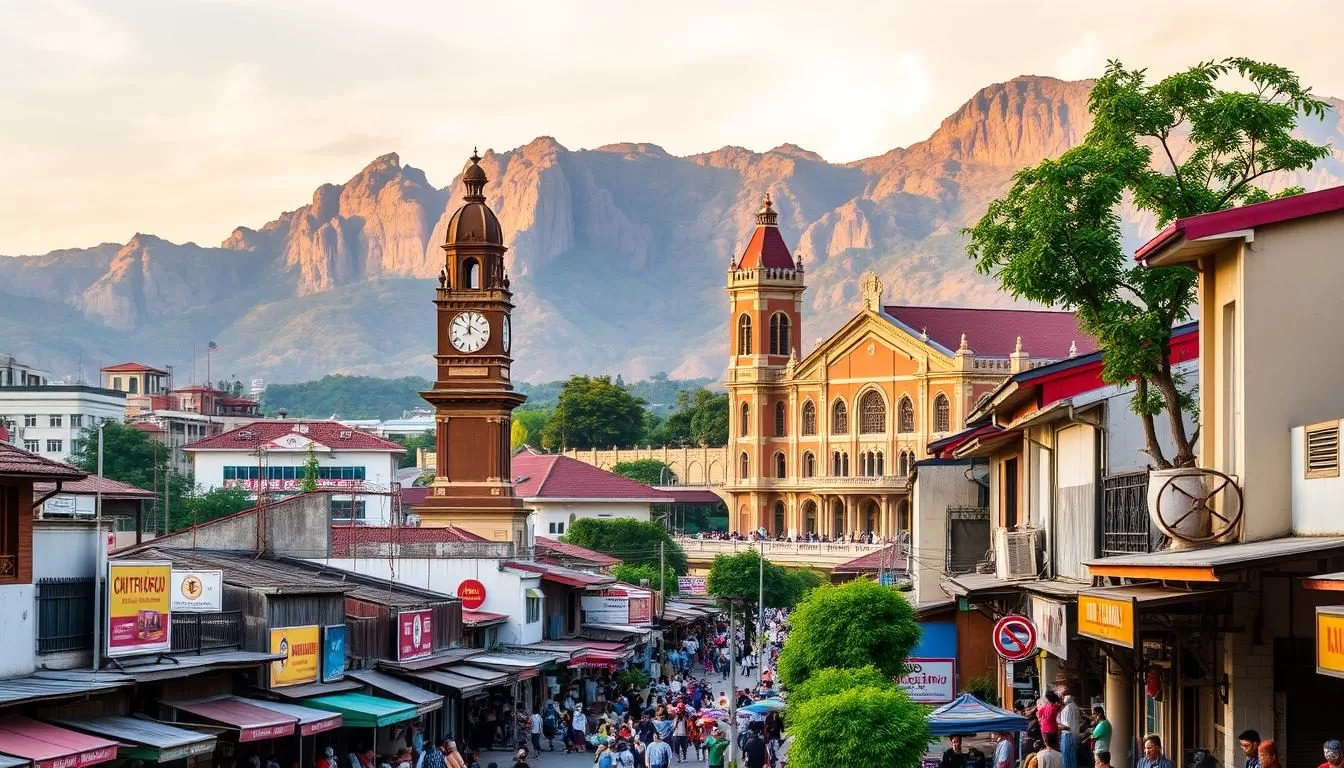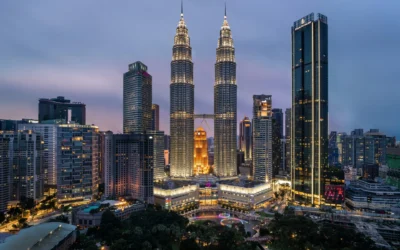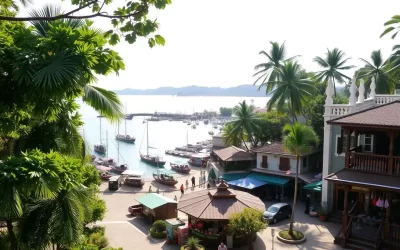✓ Accommodations✓ Flights✓ Rental Cars
Discover the hidden gem of Ipoh, a city that seamlessly blends colonial charm with modern hipster culture. Located about 200 kilometres north of Kuala Lumpur, Ipoh is a treasure trove of exciting experiences waiting to be explored.
As you wander through the charming Old Town, you’ll be treated to a visual feast of colonial architecture, vibrant street art, and trendy cafes. The city is also surrounded by spectacular limestone cave temples, offering a unique spiritual and visual experience. With its rich history as a former tin mining hub, Ipoh has a lot to offer, from its world-famous White Coffee to its diverse culinary scene, making it a paradise for food lovers.
You’ll find that Ipoh provides a more authentic experience compared to more touristy destinations. With a lot to see, eat, and stay, you’re sure to have a memorable trip.
Discovering Ipoh: Malaysia’s Hidden Gem

Tucked away in the Malaysian countryside, Ipoh is a hidden gem that promises an unforgettable experience. This charming city, with its rich history and cultural heritage, is a perfect blend of the old and the new.
Where is Ipoh Located?
Ipoh is situated about 200 kilometers north of Kuala Lumpur, making it an ideal stopover between the capital and Penang. The city is nestled among dramatic limestone hills, creating a stunning backdrop that adds to its natural charm.
Why Visit Ipoh?
Ipoh is worth visiting for its rich history, evident in its well-preserved old town area. The city earned its nickname “City of Millionaires” during the tin mining boom of the late 19th and early 20th centuries, and this prosperity is still visible in its colonial architecture. Over time, Ipoh has transformed from a bustling mining town to a cultural hub, offering visitors a unique blend of Malaysian culture, food, and history without the crowds. With its authentic Malaysian experience and fewer tourists, Ipoh is an attractive destination for travelers looking to explore beyond the usual tourist spots.
Explore the Charming Old Town
Step into Ipoh’s Old Town, a treasure trove of history, culture, and charm. This compact area is filled with colonial-era buildings, traditional shophouses, and a network of charming streets that tell the story of the city’s past.

Concubine Lane: Shopping and History
Between two of the Old Town’s main streets is Concubine Lane, a narrow pathway that feels like stepping back in time to the 1950s. The risqué name is rumoured to be due to businessman Yao Tet Shin providing his mistress with a house to live in here. This narrow alley is lined with quaint shophouses that have mostly been turned into modern shops, restaurants, and other attractions.
You’ll find an array of vintage trinkets as well as more modern wares like phone cases. Concubine Lane is a cute, narrow lane flanked by old-style Chinese shophouses, complete with shutters and beautiful tiles.
Market Lane and Wife Lane
Visit the less crowded but equally fascinating Market Lane and Wife Lane, which together with Concubine Lane were gifted by tin mining tycoon Yau Tet Shin to his wife and concubines. These lanes offer a glimpse into the past, with their historic buildings and stalls selling souvenirs and typical foods of the area.
Ipoh Heritage Trail
Follow the Ipoh Heritage Trail starting at the magnificent Ipoh Railway Station, a colonial masterpiece built in 1917 that combines Moorish architecture with modern function. Learn about the historical significance of buildings like the Ipoh Town Hall, the High Court, and the FMS Bar and Restaurant, said to be the oldest bar in the country.
Observe how local people go about their daily lives in this historical setting, creating a fascinating blend of past and present in the streets of Old Town, showcasing the city’s history and charm.
Visit the Spectacular Cave Temples

Just outside Ipoh’s city center, you’ll discover magnificent cave temples carved into the dramatic limestone hills that surround the city. These temples are not only a testament to the region’s natural beauty but also to its rich spiritual heritage.
Sam Poh Tong Cave Temple
Sam Poh Tong is a marvel of natural and manmade beauty and is considered the biggest cave temple in Malaysia. As you step through the entrance and into the cave, you’ll discover intricate shrines and Buddha statues adorning the temple’s interior, interspersed with majestic stalactites and stalagmites.
Upon walking through the cave, you’ll emerge in a serene garden surrounded by high limestone cliffs, complete with a turtle pond where you can feed these sacred creatures.
Perak Tong Cave Temple
Perak Tong stands as one of the most revered cave temples in Ipoh, housing a 12-meter Golden Buddha statue. To reach the temple’s inner sanctum, you’ll need to climb about 450 steps, but the panoramic view from the cave’s entrance makes the climb worthwhile.
The climb rewards you with ornate sculptures and intricate artwork adorning the walls, making it a truly enriching experience.
Ling Sen Tong Temple
Ling Sen Tong Temple is a vibrant Taoist cave temple, known for its brightly colored statues, mostly depicting mythical figures from Chinese folklore. The temple courtyard is a kaleidoscope of colors, creating a unique and captivating atmosphere.
These temples offer a glimpse into the spiritual significance of the region and how they blend religious devotion with natural cave formations. Consider taking a guided tour that combines visits to multiple cave temples and other attractions.
Hunt for Street Art in Ipoh
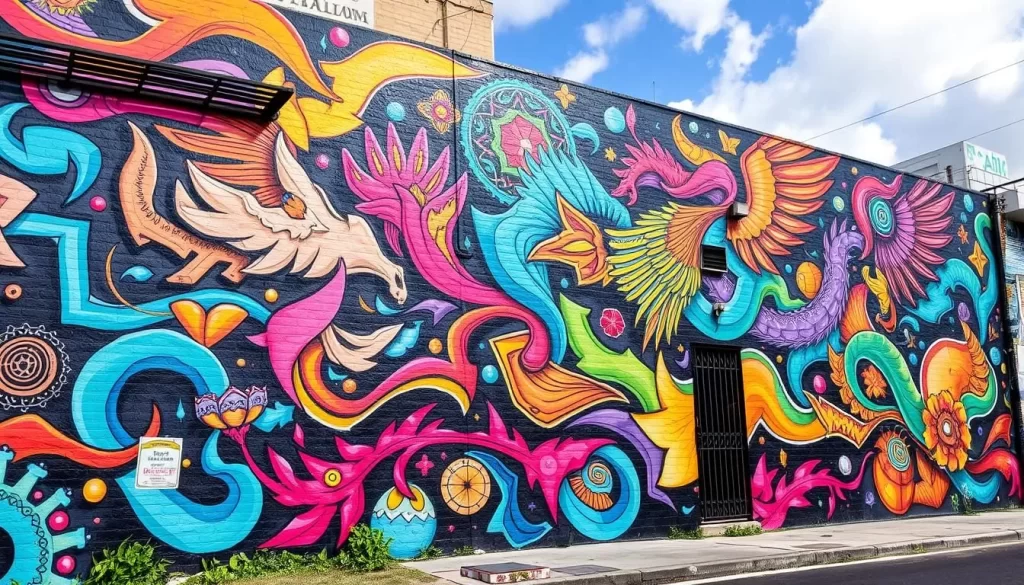
As you wander through Ipoh’s charming streets, you’ll discover a vibrant street art scene that brings the city’s history and culture to life. The city’s weathered buildings now serve as canvases for local and international artists.
The street art in Ipoh is not just aesthetically pleasing; it also tells the story of the city’s transformation and its people’s resilience. One of the notable artists featured in Ipoh is Ernest Zacharevic, known for his interactive 3D murals.
Ernest Zacharevic’s Murals
Ernest Zacharevic’s larger-than-life wall murals have garnered international attention. His work incorporates real objects, making the art interactive and engaging.
Mural Art’s Lane
Another must-visit spot is Mural Art’s Lane in Ipoh New Town, a narrow alley filled with colorful street art depicting Malaysian culture and daily life. You can also find murals around Concubine Lane, adding to the city’s cultural narrative.
By exploring Ipoh’s street art, you’ll gain a deeper understanding of the city’s history, culture, and its people’s stories.
Discover Ipoh’s Hidden Natural Wonders
Venture beyond Ipoh’s old town, and you’ll uncover the city’s most breathtaking natural gems.
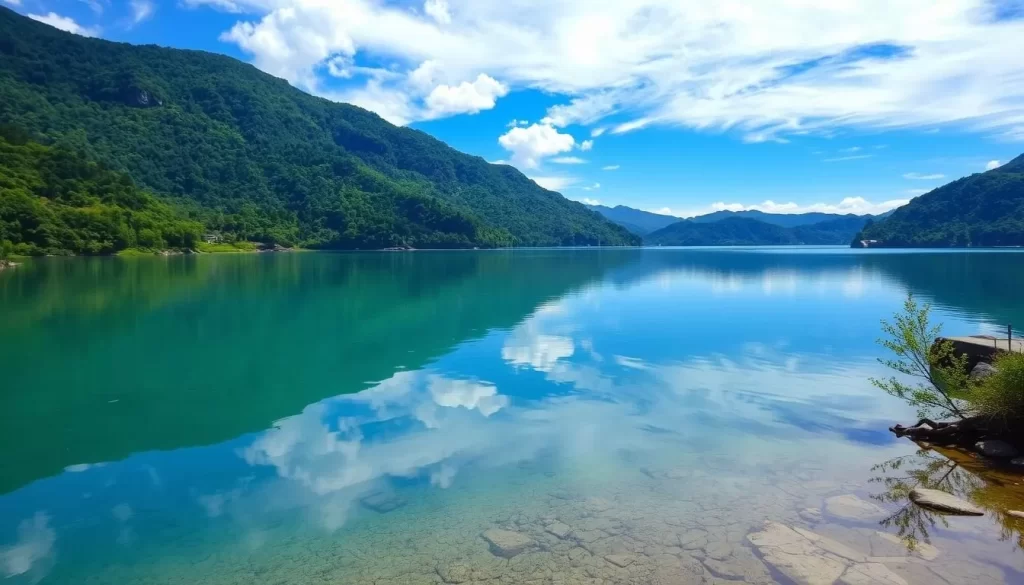
Tasik Cermin (Mirror Lake)
Tasik Cermin, or Mirror Lake, is one of Ipoh’s best-kept secrets, nestled at the base of towering limestone cliffs. The lake’s unique setting, surrounded by limestone karsts, earns it the nickname ‘Mirror Lake’ due to the perfect reflections on its calm waters at certain times of day.
You can access the lake through Miner’s Tunnel, a passage excavated by Hakka Chinese miners in the 1900s. A tour of the lake offers a peaceful boat ride, allowing you to fully appreciate the dramatic natural scenery and tranquility of this hidden cave temple area.
To make the most of your visit, arrive early in the morning for the best mirror-like reflections and to avoid the crowds. Combining your visit to Mirror Lake with nearby cave temples like Sam Poh Tong and Ling Sen Tong makes for a full day of exploring Ipoh’s limestone hill area.
Kinta Riverfront Walk
After exploring the natural wonders, take a stroll along the scenic Kinta Riverfront Walk, a peaceful riverside promenade perfect for ending a busy day of sightseeing. The riverfront is lined with art installations, cafes, and food stalls, offering a relaxing atmosphere.
You can also hire a bike and cycle along the riverfront if you’d like to explore further. At the weekends and evenings, enjoy cultural performances and live music, adding to the vibrant ambiance of the area.
Ipoh, Malaysia: Best Things to Do for Food Lovers

Ipoh, Malaysia, stands out as a top food destination, thanks to its unique blend of cultures and cuisines. The city’s culinary scene is a reflection of its history and cultural diversity, making it a haven for food enthusiasts.
Try the Famous Ipoh White Coffee
Ipoh White Coffee has become a sensation worldwide, and its origins date back to the 1800s during the tin-mining boom. The Hainanese immigrants adjusted the Western-style coffee to suit their taste by roasting coffee beans in margarine, creating a milder flavor with hints of caramel. This unique brew is typically served with sweetened condensed milk.
Must-Try Local Dishes
Ipoh is known for its array of local delicacies. Some must-try dishes include Beansprout chicken (tauge ayam), a variation of the traditional chicken rice, and Chee Cheong Fun, a rice noodle roll served with curry and mushroom gravy. Kai si hor fun, a rice noodle soup in chicken and prawn stock, is another favorite among locals and visitors.
Best Places to Eat in Ipoh
The Old Town area is home to many historic buildings that house excellent restaurants and eateries. Visitors can enjoy a meal in an atmospheric setting while savoring local cuisine. Hawker centers are also a great place to experience the city’s food culture, with a variety of affordable and authentic dishes available.
When in Ipoh, take the opportunity to experience the local food scene, which is deeply influenced by the city’s history and culture. With its unique flavors and dishes, Ipoh is sure to leave a lasting impression on any food lover.
Shop Till You Drop

You’ll find a treasure trove of shopping delights in Ipoh’s Old Town, where tradition meets modernity. The area is filled with charming shops and stalls selling everything from handmade souvenirs to stylish clothing.
Kong Heng Market
The Kong Heng Market is a must-visit destination for any shopper. Located behind the popular Plan B restaurant, this market offers a wide range of products, including handmade jewelry, accessories, and unique souvenirs. The market is open daily from 10 AM to 5 PM, making it a great place to spend your afternoon.
Unique Boutiques and Souvenir Shops
Ipoh’s Old Town is home to a variety of unique boutiques and souvenir shops. You can find stylish clothing at “What to Wear,” a Malaysian clothing brand with several stores in Ipoh. For book lovers, BookXcess is a must-visit, housed in an old bank where you can hunt for your next read among bank vaults and safety deposit boxes. As you wander down Concubine Lane, you’ll discover street art-inspired souvenirs and chic boutiques with stalls lining the street, selling everything from clothing to games.
When shopping in Ipoh, be sure to explore the historic buildings that have been repurposed into shopping spaces, preserving the area’s architectural heritage while supporting local businesses.
Experience Ipoh’s Nightlife
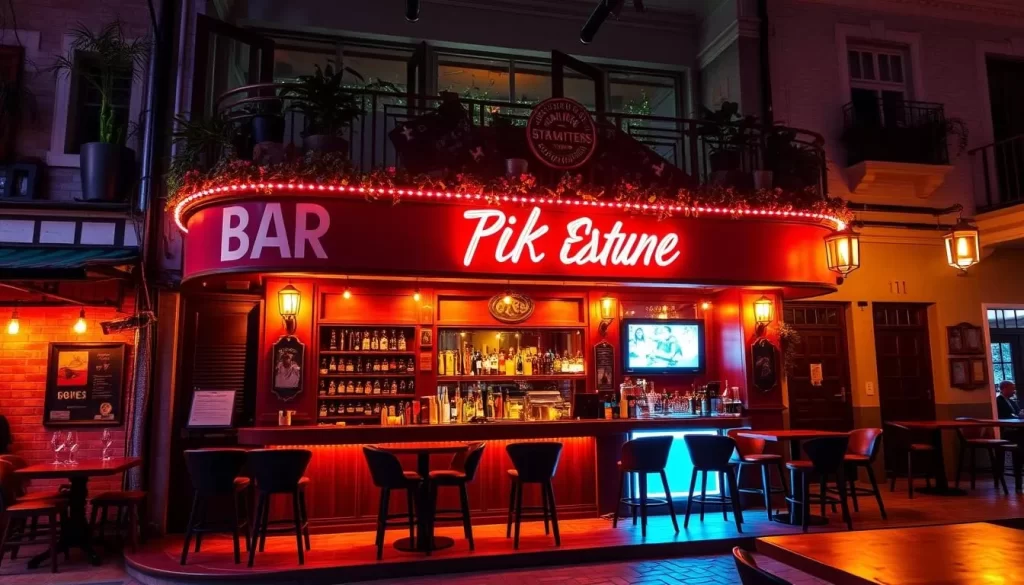
Ipoh’s weathered buildings hide a surprising nightlife scene. As you walk through the Old Town, you’ll discover secret bars and speakeasies that offer a unique evening experience. These hidden gems are perfect for a stylish night out, sipping on creative cocktails in cozy, nostalgic settings.
Hidden Bars and Speakeasies
Caina Bank is one of Ipoh’s best-kept secrets, where you’ll find a cozy space with Chinese decor and a fiery red glow after climbing nondescript stairs and entering through a vault door. The bartenders craft unique cocktails with Asian-inspired flavors tailored to your taste. Another gem is Tiga Cocktail Bar, a nostalgic speakeasy that pays homage to Ipoh’s past.
Evening Entertainment Options
As night falls, Ipoh transforms, with street art illuminated by creative lighting and historic buildings taking on a mysterious atmosphere. You can join a bar crawl to explore multiple hidden drinking spots or visit the Kinta Riverfront area for cultural performances and live music. Ipoh offers a range of nightlife options, from sophisticated cocktail lounges to casual beer gardens serving “snow beer” – beer served in a frozen glass for a refreshing experience.
Day Trips from Ipoh
You can experience the best of Malaysia’s natural beauty and culture by taking a day trip from Ipoh. The city is strategically located, making it an ideal base for exploring the surrounding Perak state.

Cameron Highlands
Located about 2 hours from Ipoh, the Cameron Highlands offer a cool escape from the heat. You can explore the rolling hills covered with bright green tea plantations and visit a tea factory to learn about the tea-making process.
Kuala Kangsar
For a dose of history and culture, head to Kuala Kangsar, the royal capital of Perak state. Easily reached by train or bus in about 30 minutes from Ipoh, Kuala Kangsar is home to the Ubudiah Mosque, the Royal Museum, and the Malay College.
Gua Tempurung Cave
About 25 kilometers south of Ipoh lies Gua Tempurung, one of Peninsular Malaysia’s largest cave systems. You can choose from various guided tours, ranging from easy dry walks to adventurous wet tours where you’ll wade through the underground river.
These day trips offer a great way to experience the diversity of the region, from natural wonders to cultural landmarks. Consider combining your trip with visits to other attractions like Mirror Lake or lesser-known cave temples in the area.
Practical Information for Visiting Ipoh
Planning a trip to Ipoh, Malaysia, requires some practical information to make the most of your visit. Understanding how to get there, the best time to visit, where to stay, and how to plan your days will enhance your travel experience.
How to Get to Ipoh
Ipoh is conveniently located on the main train line between Kuala Lumpur and Penang, making the Ipoh Railway Station a key arrival point. You can easily reach Ipoh by train, which is the most convenient public transport option. Alternatively, many bus connections serve Ipoh, although they arrive at a new terminal outside the city center. From there, you can take a taxi for about 25RM or hop on a local bus that comes every 30-60 minutes.
Best Time to Visit
The best time to visit Ipoh is between November and February, during the dry season. While Malaysia is a tropical country and may still experience some rain, the likelihood is less during this period. Visiting in February, for instance, you might still encounter short afternoon thunderstorms, but these typically last only about 30 minutes.
Where to Stay in Ipoh
Ipoh has two main areas to stay: New Town and Old Town. The Old Town offers heritage charm and proximity to historical attractions, while New Town provides more modern accommodation options. Both areas are within a 10-minute walk of each other, so you’re never far from the top things to do. You can choose from luxury hotels like The Banjaran Hotsprings Retreat or mid-range hotels like Kinta Riverfront Hotel.
How Long to Spend in Ipoh
It’s recommended to spend at least two days in Ipoh to explore the city center and visit the natural attractions on the outskirts. This duration allows you to visit the cave temples and enjoy the local food culture without feeling rushed. With two to three days, you can experience the best of Ipoh, including leisurely meals and coffee breaks, which are an integral part of the Ipoh experience.
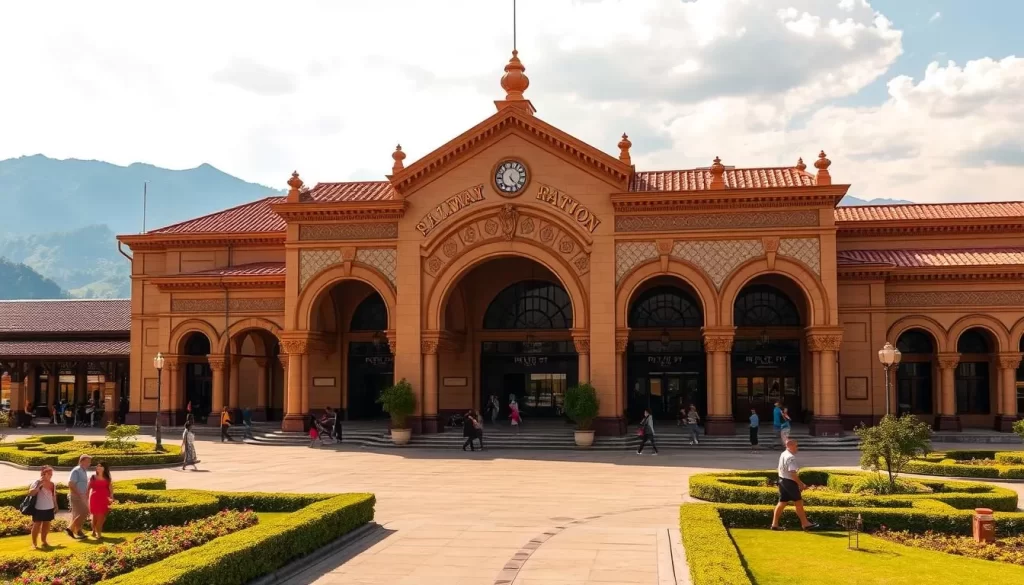
Conclusion
Discover the charm of Ipoh, a city that seamlessly blends old and new. You’ll find that Ipoh offers the perfect blend of cultural heritage, natural beauty, and culinary delights, making it one of Malaysia’s most underrated destinations. The city’s cave temples, such as Sam Poh Tong and Ling Sen Tong, are a testament to its rich history and cultural significance.
As you explore Ipoh’s historic streets and street art, you’ll experience the city’s unique blend of heritage and modern culture. Be sure to try the famous white coffee and sample the local cuisine. With its old town charm and natural wonders like Mirror Lake, Ipoh is a place that will leave you with lasting memories. Plan to spend at least 2-3 days in Ipoh to fully appreciate its many attractions.
The above is subject to change.
Check back often to TRAVEL.COM for the latest travel tips and deals.
